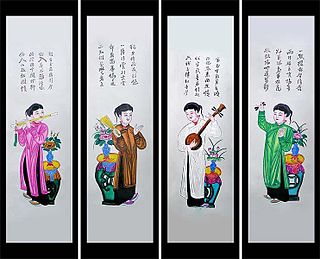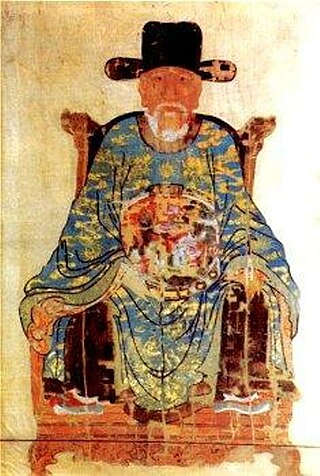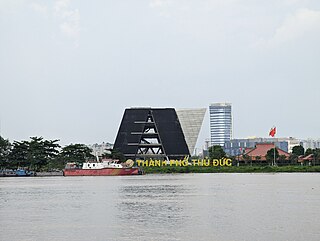Related Research Articles

The history of Vietnam can be traced back to around 20,000 years ago. The first modern humans to arrive and settle in the area of modern-day Vietnam are known as the Hoabinhians, who can be traced as the ancestors of modern-day Negritos. Archaeological findings from 1965, which are still under research, show the remains of two hominins closely related to the Sinanthropus, dating as far back as the Middle Pleistocene era, roughly half a million years ago.
Articles related to Vietnam and Vietnamese culture include:

The Fourth Era of Northern Domination was a period of Vietnamese history, from 1407 to 1427, during which Vietnam was ruled by the Chinese Ming dynasty as the province of Jiaozhi. Ming rule was established in Vietnam following its conquest of the Hồ dynasty. The previous periods of Chinese rule, collectively known as Bắc thuộc, lasted much longer and amounted to around 1000 years. The fourth period of Chinese rule over Vietnam was eventually ended with the establishment of the Later Lê dynasty.

The Lê dynasty, also known in historiography as the Later Lê dynasty, officially Great Việt, was the longest-ruling Vietnamese dynasty, having ruled from 1428 to 1789, with an interregnum between 1527 and 1533. The Lê dynasty is divided into two historical periods: the Innitial Lê dynasty before the usurpation by the Mạc dynasty, in which emperors ruled in their own right, and the Revival Lê dynasty, in which emperors were figures reigned under the auspices of the powerful Trịnh family. The Revival Lê dynasty was marked by two lengthy civil wars: the Lê–Mạc War (1533–1592) in which two dynasties battled for legitimacy in northern Vietnam and the Trịnh–Nguyễn Wars between the Trịnh lords in North and the Nguyễn lords of the South.

Lê Lợi, also known by his temple name as Lê Thái Tổ (黎太祖) and by his pre-imperial title Bình Định vương, was a Vietnamese rebel leader who founded the Later Lê dynasty and became the first Emperor of the restored kingdom of Đại Việt after the country was conquered by the Ming dynasty. In 1418, Lê Lợi and his followers rose up against Ming rule. He was known for his effective guerrilla tactics, including constantly moving his camps and using small bands of irregulars to ambush the larger Ming forces. Nine years later, his resistance movement successfully drove the Ming armies out of Vietnam and restored Vietnamese independence. Lê Lợi is among the most famous figures of Vietnamese history and one of its greatest heroes.

Nguyễn Trãi (阮廌), pen name Ức Trai (抑齋); (1380–1442) was an illustrious Vietnamese Confucian scholar, a noted poet, a skilled politician and a master strategist. He was at times attributed with being capable of almost miraculous or mythical deeds in his designated capacity as a principal advisor of Lê Lợi, who fought against the Ming dynasty. He is credited with writing the important political statements of Lê Lợi and inspiring the Vietnamese populace to support open rebellion against the Ming dynasty rulers. He is also the author of "Great Proclamation upon the Pacification of the Wu".

The Anarchy of the 12 Warlords, also the Period of the 12 Warlords, was a period of chaos and civil war in the history of Vietnam, from 965 to 968 caused by the succession of the Ngô dynasty after the death of King Ngô Quyền. This period is also sometimes simply called the Twelve Warlords. Four of the warlords are verified to have traced their direct lineage from what is now China today. This period ended in 968 with the unification war of Vietnam by Đinh Bộ Lĩnh, who later established the Đinh dynasty.

Paris By Night 90: Chân Dung Người Phụ Nữ Việt Nam is a Paris By Night program produced by Thúy Nga that was filmed at the Terrace Theater at the Long Beach Convention and Entertainment Center on September 15, 2007 and September 16, 2007.

Paris By Night 78: Đường Xưa is a Paris By Night program produced by Thúy Nga that was filmed at the Canadian Broadcasting Centre Studio #40 in Toronto, Canada on June 11, 2005. The MC's were Nguyễn Ngọc Ngạn and Nguyễn Cao Kỳ Duyên. Seats are limited to a studio audience and is considered a private event.
Ngô Sĩ Liên (吳士連) was a Vietnamese historian of the Lê dynasty. He was the main compiler of the Đại Việt sử ký toàn thư, a chronicle of the history of Vietnam and a historical record of a Vietnamese dynasty. Ngô based information for his historical book from collections of myths and legends such as Trần Thế Pháp's Lĩnh Nam chích quái or Việt điện u linh tập.

Bình Ngô đại cáo was an announcement written by Nguyễn Trãi in 1428, at Lê Lợi's behest and on Lê Lợi's behalf, to proclaim the Lam Sơn's victory over the Ming imperialists and affirm the independence of Đại Việt to its people.
Liu Shan was a general of the Ming dynasty era of Chinese history. The Emperor of China called upon him to lead a massive army to crush the Lam Sơn uprising in Vietnam, led by the landowner Le Loi. After the defeat of the Chinese armed forces at the Battle of Tot Dong, he took command of the Chinese armies outside of the capital city. Liu Shan commanded a 100,000-strong force of Chinese troops to attack the Vietnamese troops to start the Battles of Lang Son and the Red River Valley. Le Loi turned his attention to the main force, Liu Shan's, and quickly annihilated them. Liu Shan was captured, and summarily executed.

Nguyễn Bằng Kiều, is a Vietnamese ballad singer.

The Lam Sơn uprising was a Vietnamese rebellion led by Lê Lợi in the province of Jiaozhi from 1418 to 1427 against the rule of Ming China. The success of the rebellion led to the establishment of the Later Lê dynasty by Lê Lợi in Đại Việt.

The Battle of Tốt Động – Chúc Động in 1426 was the decisive battle in the 14-year Lam Sơn uprising which established Vietnam's independence from Ming China in 1428. The battle took place on 4 December 1426 in the Red River Delta between Tốt Động and Chúc Động, two villages of Chương Mỹ District, near Hanoi. Armed with hand cannons, the Vietnamese force of 3,000-men under Lê Lợi, the Prince of Pacification, was able to stage a successful ambush on the attacking Ming army under General Wang Tong. The Ming army was decisively routed. As a result, most of the Chinese weapons, supplies, and horses were captured by the Vietnamese. Wang Tong was forced to retreat back to Hanoi, where four days later he and the city were besieged by Le Loi's army.

Nguyễn Bặc, also known with the noble title Định Quốc Công (定國公), was a Vietnamese mandarin and general who served as the Grand Chancellor of Đinh dynasty and was the first chancellor in Vietnamese history. He helped future emperor Đinh Bộ Lĩnh put an end to the troubles of the Anarchy of the 12 Warlords and to establish the short-lived Đinh dynasty. After Đinh Bộ Lĩnh and his chosen successor Đinh Liễn were murdered by a palace official, Đỗ Thích, Nguyễn Bặc captured the murderer and had him executed. He then tried unsuccessfully to organize resistance to Lê Hoàn. According to Nguyễn Phúc tộc thế phả, Nguyễn Bặc is the ancestor of the Nguyễn clan, followed by founding of Nguyễn lords by Nguyễn Hoàng in 1569 and Nguyễn dynasty in 1802 under the emperor Gia Long. Moreover, he was considered as one of the "seven heroes of Giao Châu" according to Việt Sử tân biên including: Đinh Bộ Lĩnh, Đinh Liễn, Lê Hoàn, Đinh Điền, Phạm Hạp and Phạm Cự Lượng.

Nguyễn Xí, or Lê Xí, was a general, politician, and public servant who served as a minister for four generations of rulers during the late Lê dynasty.

Thủ Đức is a municipal city (sub-city) under the administration of Ho Chi Minh City, Vietnam.

The abdication of Bảo Đại took place on 25 August 1945 and marked the end of the 143-year reign of the Nguyễn dynasty over Vietnam ending the Vietnamese monarchy. Emperor Bảo Đại abdicated in response to the August Revolution. A ceremony was held handing power over to the newly established Democratic Republic of Vietnam, which was established during the end of World War II in Asia as Vietnam had been occupied by French and later Japanese imperialists.

Nguyễn Chí Tài ,stage name Chí Tài, was a Vietnamese comedian, musician, and singer. Initially starting as a singer in the 90s, he later became a comedian celebrity when he particiated in several comedy acts alongside his well-known stage partner Hoài Linh.
References
- ↑ "Khởi Nghĩa Lam Sơn". Thư Viện Lịch Sử Việt Nam. Retrieved 4 November 2016.
- ↑ Nguyen, Dylan. "Le Lai". Pretzi. Retrieved 4 November 2016.
- ↑ Phạm, Văn Sơn. "Việt Sử Toàn Thư".
- ↑ "Trải nghiệm nhanh chiến dịch "Lê Lợi" trong Age of Empires II HD: The Rise of the Rajas (DLC)". Trang Công Nghệ (in Vietnamese). 24 December 2016.